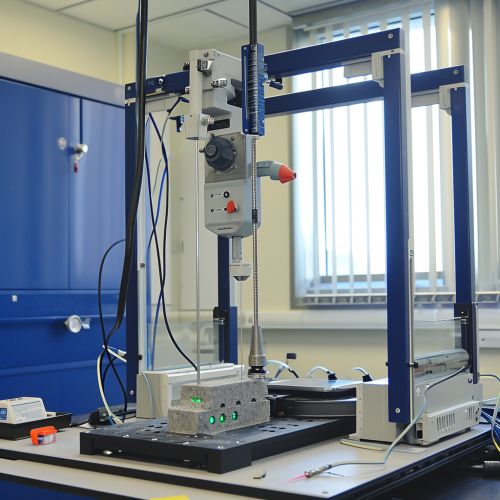Impact Testing
Introduction
Impact testing is a method used in material science to determine the behavior of materials when subjected to high strain rates. This testing is crucial in industries where materials are subjected to high impact or shock loading, such as automotive, aerospace, and defense industries. Impact testing can reveal properties such as fracture toughness, ductility, and strength of the material under impact loading conditions.


Types of Impact Tests
There are several types of impact tests, each designed to measure specific material properties under different loading conditions.
Charpy Impact Test
The Charpy Impact Test is a standardized high strain-rate test which determines the amount of energy absorbed by a material during fracture. This absorbed energy is a measure of a given material's toughness and acts as a tool to study temperature-dependent brittle-ductile transition.
Izod Impact Test
The Izod Impact Test is another standard method of impact testing. Similar to the Charpy test, the Izod test measures the energy absorbed by a standard notched specimen while being struck by a pendulum.
Drop Weight Test
The Drop Weight Test is used to measure the fracture toughness of a material. It involves dropping a weight from a certain height onto a specimen and observing the resulting damage.
Impact Testing Machines
Impact testing machines are designed to deliver a high velocity load to a test specimen. These machines can be categorized into two types: pendulum-style testing machines and drop weight testers.
Pendulum-Style Testing Machines
Pendulum-style testing machines, used in Charpy and Izod tests, employ a swinging pendulum to strike the specimen. The energy absorbed by the specimen is calculated from the loss of kinetic energy of the pendulum.
Drop Weight Testers
Drop weight testers, used in drop weight tests, employ a weight that is dropped from a specific height onto the specimen. The energy absorbed by the specimen is calculated from the loss of potential energy of the weight.
Factors Affecting Impact Testing
Several factors can affect the results of impact testing, including temperature, strain rate, and specimen geometry.
Temperature
The temperature at which the test is conducted can significantly affect the impact properties of a material. As temperature decreases, materials tend to become more brittle and absorb less energy before fracture.
Strain Rate
The strain rate, or the speed at which the load is applied, can also affect the impact properties of a material. Higher strain rates can cause materials to behave more brittle.
Specimen Geometry
The geometry of the specimen, including its size, shape, and the presence of notches, can affect the results of impact testing. Notches are often included in test specimens to simulate the stress concentrations that occur in real-world applications.
Applications of Impact Testing
Impact testing is used in a variety of industries to select materials for applications that involve shock or impact loading. Some of these industries include:
